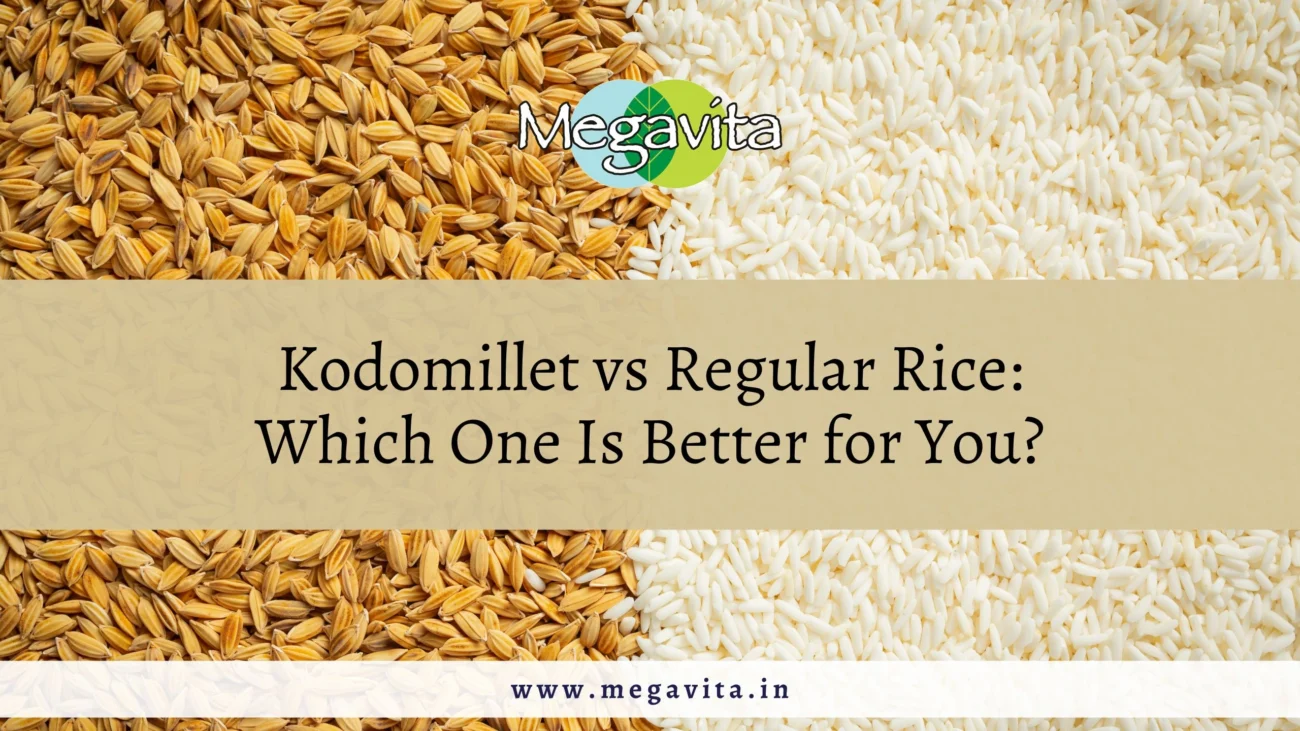
Kodo millet rice or varagu arisi or varagu rice, one of the several superfoods grains, is becoming popular along with good old brown rice and white rice. Both are constituents of a staple dish on my plate, but if nutrition, health, and sustainability equations are put into perspective, millets are winners without a doubt. In this ultimate comparison, we will guide you through the disparity between kodo millet rice and white rice—from nutritional value, glycemic load, and cooking functionality to environmental footprint, and beyond—so that you can hopefully make an informed choice in everyday dishes.
1. Nutritional Value Kodo Millet Rice
- Calories (per 100 g cooked): ~120 kcal
- Protein: 3 g
- Dietary Fiber: 2.5 g
- Iron: 1.4 mg
- Calcium: 6 mg
- Magnesium: 41 mg
- Regular White Rice
- Calories (per 100 g cooked): ~130 kcal
- Protein: 2.4 g
- Dietary Fiber: 0.4 g
- Iron: 0.2 mg
- Calcium: 10 mg
- Magnesium: 12 mg
Varagu rice contains nearly six times the fiber, over double the magnesium content, and significantly more iron compared to white rice. Even in comparison to brown rice, varagu rice contains a better ratio of nutrients such that everybody can enjoy whole grains.
2. Glycemic Index & Blood Sugar Control
The glycemic index (GI) measures how quickly the carbohydrates in a food elevate blood glucose levels relative to a standard reference.
Kodo Millet Rice (Varagu Rice): GI ~54 (low)
White Rice: GI ~73 (high)
Brown Rice: GI ~68 (moderate)
Low-GI food like varagu arisi is slowly digested, thereby reducing blood sugar peaks and giving long-lasting energy. Hence, kodo millet rice would be ideal for diabetics or even otherwise to naturally stabilize blood sugars.
3. Satiety & Digestive Health
Because of the high fiber content in kodo millet rice, it facilitates smooth digestion and gut health maintenance via nutritional conditioning of healthy gut microbiota. The fiber also provides satiation for longer periods, and this is able to inhibit excessive food consumption and render achievement of weight loss simple. Fiber-free white rice can cause quick digestion and quick satiation of hunger.
4. Cardiovascular Wellbeing & Cholesterol Management
Kodo millet rice has established antioxidant phytochemicals and magnesium with cardioprotective properties. Daily consumption has been reported to reduce the levels of LDL (“bad”) cholesterol and maintain blood pressure in a normal state. White rice provides very few micronutrients, and even brown rice—though marginally better—still falls short of the rich nutrient density found in varagu rice.
5. Fat Content & Amino Acid Pattern
Both rice and kodo millet are not a complete protein, but kodo millet rice has more total protein and otherwise a superior amino acid score than white rice. Varagu arisi is a complete protein food when consumed along with dals or legumes and therefore is an ideal staple food among vegetarians as well as vegans.
6. Cooking Ease & Versatility
Kodo Millet Rice (Varagu Rice)
- Flavor Profile: Light nutty flavor
- Texture: Light and fluffy when cooked
Cooking Tip: Soak the millet for 30 minutes, then use a 1:2 ratio of grain to water and cook on low heat for 15–20 minutes until soft.
Normal Rice
- Flavor: Neutral (white rice), light nutty (brown rice)
- Texture: Sticky (white rice), chewy (brown rice)
- Cooking Tips: Wash until clear water comes through; 1:1.5 (white) or 1:2 (brown) ratio
The fast cooking texture and spongy texture of kodo millet make it the perfect pilaf, salad, porridge, and even dessert. Its earthy undertones blend seamlessly with cumin, turmeric, and curry leaves, turning any classic preparation into a memorable culinary delight.
7. Environmental Impact & Sustainability
Unlike traditional paddy rice, varagu rice thrives with minimal water, fewer inputs, and reduced reliance on chemicals. As very tolerant soils, they are agricultural resource conservers, i.e., kodo millet rice is a green crop. Rice paddies are water guzzlers and release methane gas, a very potent green house gas.
8. Economic & Local Benefits
Where varagu arisi is a local crop to plant—e.g., South Indian regions—the local farmer is eased by use of varagu arisi, farm crop diversification is guaranteed. Thus, diversified incomes provide small-scale farmer sustenance and rural economy resilience improvement with rising kodo millet rice demand.
9. Cost Factors
Although kodo millet rice is pricier than plain white rice, the green and healthy plus is a premium worth paying. Seasonal push and bulk purchase (online) will fill the cost gap. For smart online shoppers of barley powder or other functional gruels, low-cost opportunities with extendable supply chains are in their interest today.
10. Who Can Afford Kodo Millet Rice
- Diabetics & Pre-Diabetics: For optimal control of blood sugar
- Weight Watchers: For satiation in the long run
- Heart-Health Champions: For lowering cholesterol
- Vegetarians & Vegans: For increased plant protein
- Eco-Friendly Foodies: For reduced environmental impact
You may prefer to experiment with international cuisine or just want to substitute an unhealthy one, kodo millet rice can be easily added to South Indian cuisine, hipster grain bowls, etc.
Conclusion: Adopt Varagu Rice with MegaVita
If kodo millet rice and normal rice sit on the same table, numbers are numbers: varagu rice is superior in terms of nutrition, low glycemic, and provides maximum environmental benefits. If it has to regulate blood sugar, an upgrade in fiber intake or green farming has to be done, kodo millet rice (varagu arisi) must be your top priority.
Ready to make the switch? Trust MegaVita—the best millet brand in india—to deliver the finest, farm-fresh varagu rice rich in taste, nutrition, and sustainability. Experience our Kodomillet & Rice range and put yourself on the wellness road today!

